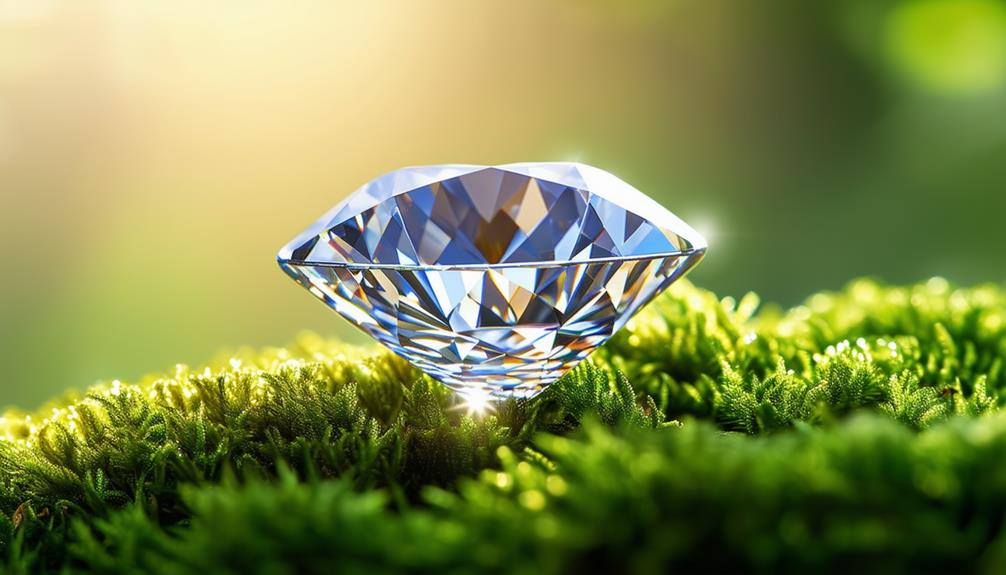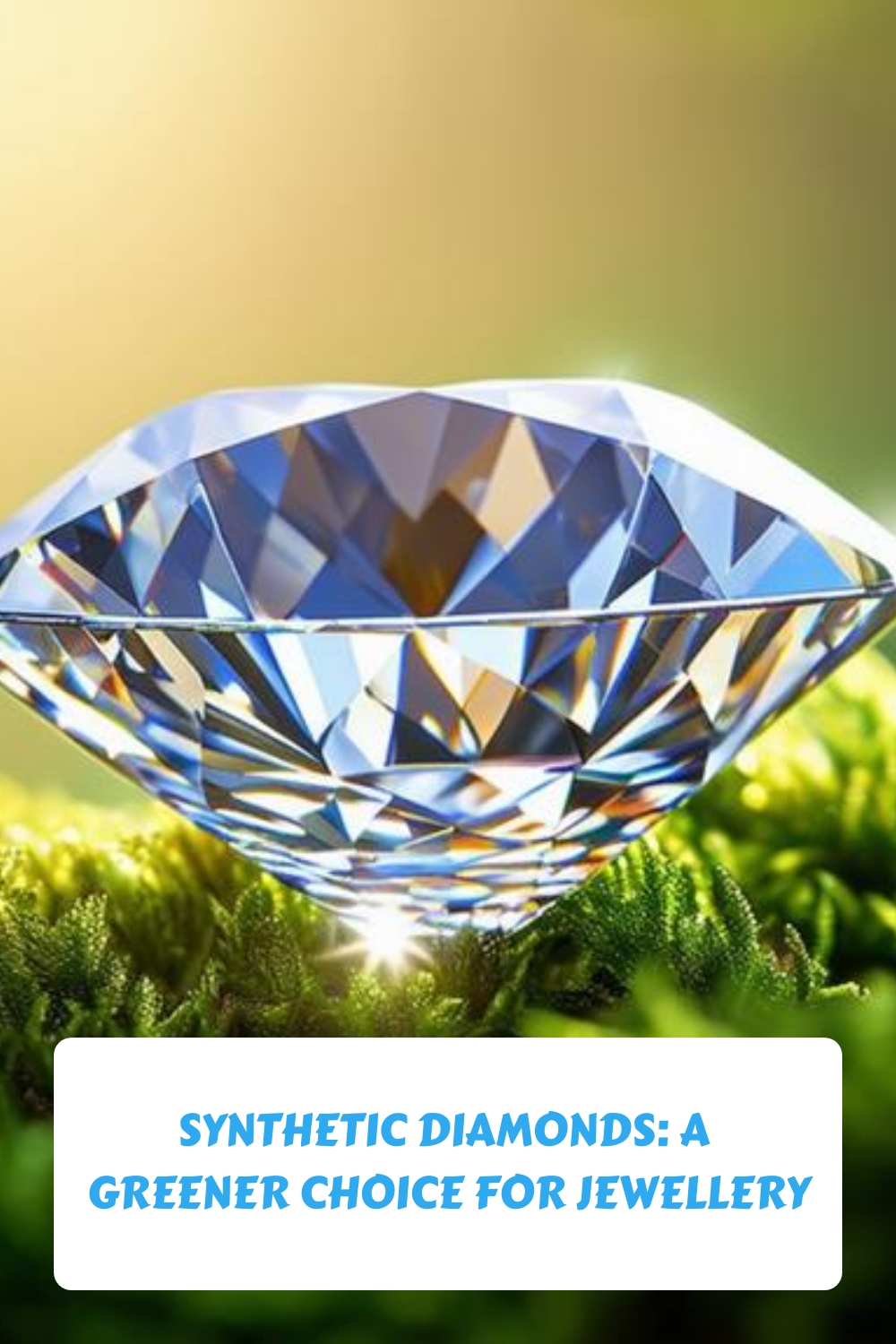Article Contents
Synthetic diamonds, created in controlled laboratory environments, represent a significant advancement in sustainable luxury. These diamonds mimic the visual and structural properties of naturally mined diamonds but cause minimal environmental damage. They require fewer resources such as energy and water, thereby reducing greenhouse gas emissions and minimising ecological disruption.
The production process follows strict ethical labour practices, making these diamonds particularly appealing to eco-conscious consumers. As pioneers in environmentally friendly jewellery, synthetic diamonds offer both aesthetic appeal and ethical assurance. Further exploration may reveal more advantages for informed buyers.
Key points
- The manufacturing of synthetic diamonds requires significantly less energy and water, making them a more sustainable choice.
- By avoiding the need for mining, synthetic diamond production helps preserve natural environments and the species that inhabit them.
- Synthetic diamonds produce fewer greenhouse gases, offering a smaller carbon footprint than their mined counterparts.
- Employing high labour standards and cutting-edge technologies, synthetic diamonds are associated with ethical production methods.
- As demand grows for sustainable options, synthetic diamonds are becoming increasingly popular in the eco-friendly jewellery market.
Origins of Synthetic Diamonds
Synthetic diamonds are produced in laboratories by mimicking the extreme conditions of high pressure and temperature that naturally occur deep within the Earth. This method of creation in controlled environments differs significantly from the natural geological processes, ensuring not only uniform quality but also broadening their use in various industries. These lab-created diamonds are precisely engineered for specific applications such as cutting tools, electronic components, and high-performance bearings, demonstrating their utility beyond mere decorative purposes.
Technological advances have significantly improved the production of synthetic diamonds, making them almost identical to natural diamonds in appearance and quality. This development has led to greater consumer acceptance as awareness of the ethical and environmental advantages of synthetic diamonds grows. Choosing lab-created diamonds means opting out of the environmental degradation and human rights abuses often associated with traditional diamond mining, aligning consumer choices with values of sustainability and ethical responsibility.
Minimised Ecological Disruption
Lab-grown diamonds significantly reduce the environmental impact associated with traditional diamond mining. Unlike the large-scale open-pit or underground mining operations, the facilities producing synthetic diamonds have a much smaller physical footprint. This approach substantially diminishes land disturbance and aids in the preservation of ecological systems.
Additionally, these laboratory settings effectively prevent the disruption of wildlife habitats, a prevalent issue in conventional mining practices. For eco-conscious consumers, choosing lab-grown diamonds means supporting sustainable practices that are in line with environmental conservation efforts. This method not only preserves natural landscapes but also maintains the health of local ecosystems, providing an environmentally friendly alternative that still offers the luxury of fine jewellery.
The production of lab-grown diamonds thus represents a responsible choice for those who prioritise environmental stewardship alongside quality craftsmanship, making it a suitable option for consumers who are mindful of sustainability.
Reduced Energy and Water Consumption
Lab-grown diamonds significantly reduce the ecological impact by using much less energy and water compared to traditional mined diamonds. This makes them a viable and sustainable choice in the jewellery market, serving both luxury and environmental conservation needs.
- Energy Efficiency: Lab-grown diamonds require up to 250 million joules less energy per carat than mined diamonds, showing a strong commitment to reducing energy consumption.
- Water Conservation: The production of synthetic diamonds uses up to 96% less water per carat, setting a standard for water conservation in the industry.
- Reduced Energy Intensity: Generating a carat of lab-grown diamonds requires significantly less energy, promoting a more sustainable method in terms of energy use.
- Minimal Water Resources: The minimal water needed in the production of lab-grown diamonds highlights their role as an environmentally friendly option, helping to preserve vital water resources.
These characteristics confirm that synthetic diamonds are not only aesthetically pleasing and durable but are also crucial for advancing sustainability. They provide a more environmentally conscious choice for consumers who value both elegance and the conservation of natural resources.
Minimal Carbon Footprint
Synthetic diamonds significantly reduce the environmental impact compared to traditionally mined diamonds. They emit considerably fewer greenhouse gases during production, which aligns with the preferences of environmentally conscious consumers who favour sustainable manufacturing practices. By opting for synthetic diamonds, consumers demonstrate a commitment to both style and environmental responsibility.
Additionally, the production of lab-grown diamonds consumes less energy and water per carat than traditional mining, further lessening their ecological footprint. This efficient use of resources contributes to a more sustainable approach in the jewellery industry.
Choosing synthetic diamonds allows individuals to embrace elegance while adhering to their ethical values, supporting efforts to protect and preserve our natural environment. In doing so, synthetic diamonds not only beautify but also symbolise a pledge towards environmental stewardship.
Ethical Production Methods
Ethical production methods ensure that the creation of synthetic diamonds does not harm ecosystems, wildlife, or human communities. These methods are integral to sustainable practices, illustrating the environmental advantages of selecting lab-created diamonds over mined ones. Ethical production helps to conserve the natural environment and respects the right of future generations to inherit an undamaged planet.
Key facets of ethical production methods include:
- Advanced technologies: Techniques like Chemical Vapor Deposition and High-Pressure High-Temperature are used, which have a lower environmental footprint.
- Labour rights: Synthetic diamonds are produced without the human rights abuses often seen in traditional diamond mining, maintaining high ethical labour standards.
- Ecosystem preservation: The production processes are designed to avoid negative impacts on wildlife and their habitats, thereby promoting biodiversity.
- Sustainability focus: Each stage of production adheres to sustainable practices, from energy consumption to waste management, highlighting a commitment to environmental stewardship.
These practices ensure that each synthetic diamond produced is not only identical to mined diamonds in physical and chemical properties but also superior in terms of ethical and environmental standards, making them a more responsible choice for consumers.
Future of Sustainable Jewellery
The sustainable jewellery market is progressing as it adopts more environmentally friendly practices, including the use of lab-grown diamonds. This development shows how the industry is responding to changing consumer preferences for products that are ethical and environmentally conscious. The use of lab-grown diamonds helps to reduce the environmental impact by decreasing reliance on traditional mining, which is often linked to ecological and ethical issues.
Looking ahead, the sustainable jewellery sector is anticipated to lead in the circular economy. This future involves not only incorporating lab-grown diamonds but also designing innovative pieces with a focus on reusability and recycling. There is a growing consumer demand for such sustainable products, driven by an informed customer base that values both style and environmental sustainability.
Moreover, as more designers and brands move towards eco-friendly materials, consumers can expect a wider range of options that uphold high luxury standards and design. The adoption of lab-grown diamonds and other sustainable materials represents a significant shift in the jewellery industry, celebrating both visual appeal and a dedication to environmental responsibility.
Frequently Asked Questions
Are Synthetic Diamonds More Environmentally Friendly?
Synthetic diamonds, created in a controlled environment, typically result in lower carbon emissions and use less water compared to those obtained through traditional mining methods. This method reduces ecological impact and promotes sustainable development objectives.
What Are the Negative Impacts of Synthetic Diamonds?
The production of synthetic diamonds significantly increases greenhouse gas emissions due to their energy-intensive processes, often powered by fossil fuels. This manufacturing not only impacts ecosystems but also disrupts traditional diamond markets. Despite being marketed as an environmentally friendly option, the ecological advantages of synthetic diamonds are overshadowed by these negative effects.
What are 3 benefits of having synthetic diamonds?
Synthetic diamonds offer three main advantages: they are more cost-effective than natural diamonds, provide a wider range of designs that enhance fashion versatility, and remove the ethical concerns associated with traditional diamond mining.
Can a Jeweller Tell a Synthetic Diamond?
With advances in gem identification technology, jewellers can accurately distinguish between synthetic and natural diamonds using specialised tools. This capability ensures that consumers make informed decisions, promoting transparency in their purchases.
Conclusion
In summary, synthetic diamonds offer a sustainable and ethical alternative in the jewellery market, significantly reducing the ecological damage caused by traditional diamond mining.
These lab-created diamonds adhere to high ethical production standards, promoting a more responsible fashion industry.
As we enter a new era of sustainability, synthetic diamonds exemplify innovation and ethical progress, envisioning a future where fashion is both environmentally friendly and socially conscious.



